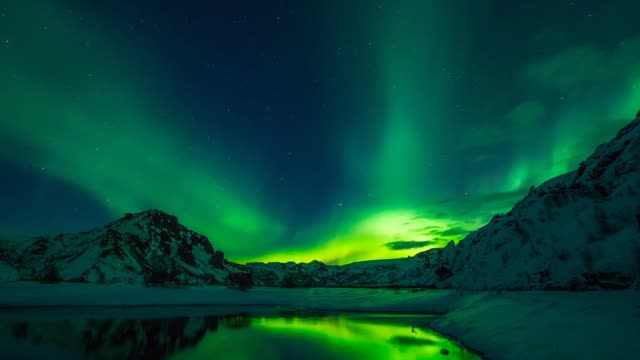Premium Only Content

An aurora[a] (plural: auroras or aurorae),[b] also commonly known as the polar lights,[c] is a natural light display in Earth's sky, predominantly seen in high-latitude regions (around the Arctic and Antarctic). Auroras display dynamic patterns of brilliant lights that appear as curtains, rays, spirals, or dynamic flickers covering the entire sky.[3]
Auroras are the result of disturbances in the magnetosphere caused by the solar wind. Major disturbances result from enhancements in the speed of the solar wind from coronal holes and coronal mass ejections. These disturbances alter the trajectories of charged particles in the magnetospheric plasma. These particles, mainly electrons and protons, precipitate into the upper atmosphere (thermosphere/exosphere). The resulting ionization and excitation of atmospheric constituents emit light of varying colour and complexity. The form of the aurora, occurring within bands around both polar regions, is also dependent on the amount of acceleration imparted to the precipitating particles.
Most of the planets in the Solar System, some natural satellites, brown dwarfs, and even comets also host auroras.
#aurora #auroras #northpole #southpole
The word "aurora" is derived from the name of the Roman goddess of the dawn, Aurora, who travelled from east to west announcing the coming of the sun.[4] Ancient Greek poets used the corresponding name Eos metaphorically to refer to dawn, often mentioning its play of colors across the otherwise dark sky (e.g., "rosy-fingered dawn").[5]
The words "borealis" and "australis" are derived from the names of the ancient gods of the north wind (Boreas) and the south wind (Auster).
Most auroras occur in a band known as the "auroral zone",[6] which is typically 3° to 6° wide in latitude and between 10° and 20° from the geomagnetic poles at all local times (or longitudes), most clearly seen at night against a dark sky. A region that currently displays an aurora is called the "auroral oval", a band displaced by the solar wind towards the night side of Earth.[7] Early evidence for a geomagnetic connection comes from the statistics of auroral observations. Elias Loomis (1860),[8] and later Hermann Fritz (1881)[9] and Sophus Tromholt (1881)[10] in more detail, established that the aurora appeared mainly in the auroral zone.
In northern latitudes, the effect is known as the aurora borealis or the northern lights. The former term was coined by Galileo in 1619, from the Roman goddess of the dawn and the Greek name for the north wind.[11][12] The southern counterpart, the aurora australis or the southern lights, has features almost identical to the aurora borealis and changes simultaneously with changes in the northern auroral zone.[13] The aurora australis is visible from high southern latitudes in Antarctica, Chile, Argentina, South Africa, New Zealand and Australia. The aurora borealis is visible from being close to the center of the Arctic Circle such as Alaska, the Canadian Territories, Iceland, Greenland, Norway, Sweden, Finland and Russia. On rare occasions the aurora borealis can be seen further south, for example in Estonia, Latvia, Lithuania, Scotland, Ireland, Denmark, and the northern part of the contiguous United States.
A geomagnetic storm causes the auroral ovals (north and south) to expand, bringing the aurora to lower latitudes. The instantaneous distribution of auroras ("auroral oval")[6] is slightly different, being centered about 3–5° nightward of the magnetic pole, so that auroral arcs reach furthest toward the equator when the magnetic pole in question is in between the observer and the Sun. The aurora can be seen best at this time, which is called magnetic midnight.
Auroras seen within the auroral oval may be directly overhead, but from farther away, they illuminate the poleward horizon as a greenish glow, or sometimes a faint red, as if the Sun were rising from an unusual direction. Auroras also occur poleward of the auroral zone as either diffuse patches or arcs,[14] which can be subvisual.
-
 LIVE
LIVE
GamingWithHemp
4 hours agoElder Scrolls Oblivion Remastered Episode #2 Ultra high settings
94 watching -
 2:11:49
2:11:49
Rotella Games
22 hours agoSaturday Morning Family Friendly Fortnite
30.7K6 -
 2:13:45
2:13:45
I_Came_With_Fire_Podcast
13 hours agoRESTRUCTURING THE WORLD- CIVICS CLASS WITH DAN HOLLAWAY
33.9K17 -
 DVR
DVR
Bannons War Room
2 months agoWarRoom Live
14.2M3.58K -
 LIVE
LIVE
Total Horse Channel
1 day agoYELLOWSTONE SLIDE I | SATURDAY
169 watching -
 23:52
23:52
The Rad Factory
6 hours ago $1.79 earnedIs My Formula Race Car Faster Than a Go Kart?
35.9K3 -
 20:56
20:56
marcushouse
6 hours ago $2.03 earnedStarship Flight Test 9 Vehicles FINALLY Prepare, and Huge Starbase Upgrades – It's All Happening!
36.3K15 -
 23:48
23:48
CatfishedOnline
20 hours agoVictim's Life is Threatened After He Gets in Too Deep With a Crypto Scammer
32.1K5 -
 8:40
8:40
Shea Whitney
7 hours ago $1.77 earned12 Fashion Mistakes Making You Look OLD & OUTDATED!
26.5K9 -
 29:18
29:18
TampaAerialMedia
8 hours ago $0.65 earnedUpdate SARASOTA, FL 2025 - St Armands, Lido, & Longboat Key
17.7K2